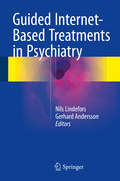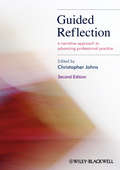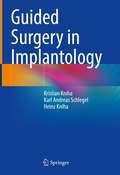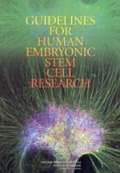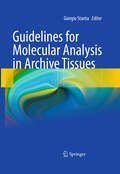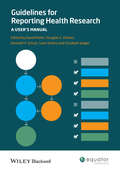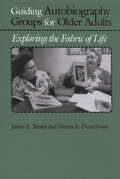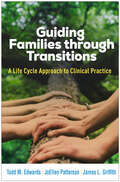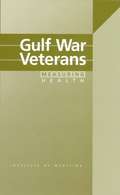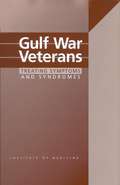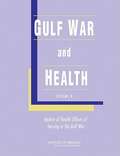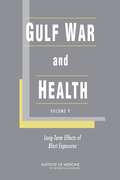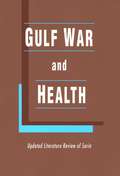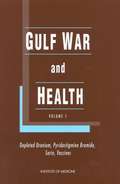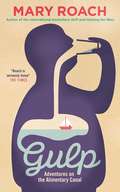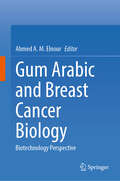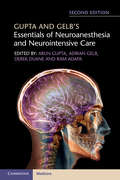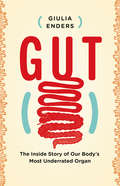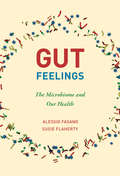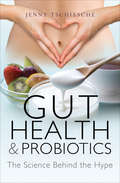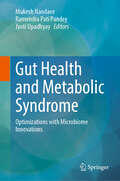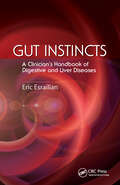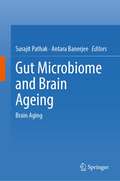- Table View
- List View
Guided Internet-Based Treatments in Psychiatry
by Gerhard Andersson Nils LindeforsThis book provides a practically oriented overview of internet-based treatments in psychiatry and mental health care, which represent a relatively new research area and offer a novel clinical approach. The principal focus is on internet-based cognitive behavior therapy, as this is currently the best example of evidence-based internet interventions in the field. Applications are described in a wide range of conditions, including, for example, depression, panic disorder, anxiety disorders, obsessive-compulsive disorder, post-traumatic stress disorder, eating disorders and addictions. Research background, clinical trials and evidence for efficacy and effectiveness are discussed and helpful case descriptions, provided. Information is also included on cost-effectiveness and other relevant aspects of health economics and on new technologies and future challenges. Guided Internet-Based Treatments in Psychiatry will be of great interest for practitioners and researchers alike.
Guided Reflection
by Christopher Johns"...an important text for practitioners...this text is a valuable tool that develops self-inquiry skills." Journal of Advanced Nursing Reflection is widely recognised as an invaluable tool in health care, providing fresh insights which enable practitioners to develop their own practice and improve the quality of their care. Guided Reflection: A Narrative Approach to Advancing Professional Practice introduces the practitioner to the concept of guided reflection, in which the practitioner is assisted by a mentor (or 'guide') in a process of self-enquiry, development, and learning through reflection in order to effectively realise one's vision of practice and self as a lived reality. Guided reflection is grounded in individual practice, and can provide deeply meaningful insights into self-development and professional care. The process results in a reflexive narrative, which highlights key issues for enhancing healthcare practice and professional care. Reflection: A Narrative Approach to Advancing Professional Practice uses a collection of such narratives from everyday clinical practice to demonstrate the theory and practicalities of guided reflection and narrative construction. In this second edition, Chris Johns has explored many of the existing narratives in more depth. Many new contributions have been added including several more innovative reflections, such as performance and art.These narratives portray the values inherent in caring, highlight key issues in clinical practice, reveal the factors that constrain the quest to realise practice, and examine the ways practitioners work towards overcoming these constraints.
Guided Surgery in Implantology
by Kristian Kniha Karl Andreas Schlegel Heinz KnihaThis book is an accurate introduction to guided implantology. As practitioners with many years of experience, the authors present an important basis for scientific findings and a valid decision-making aid for digital oral surgery.Readers are invited to learn step by step about full guided surgery. Numerous full color images demonstrate the anatomical details and risks during implantation. On top, cases are included for effective case and know-how presentation. In addition, the current literature is presented.Overall, this work appeals to beginners and experts alike.
Guidelines For Human Embryonic Stem Cell Research
by National Research Council Institute of Medicine of the National AcademiesThe National Academies Press (NAP)--publisher for the National Academies--publishes more than 200 books a year offering the most authoritative views, definitive information, and groundbreaking recommendations on a wide range of topics in science, engineering, and health. Our books are unique in that they are authored by the nation's leading experts in every scientific field.
Guidelines for Molecular Analysis in Archive Tissues
by Giorgio StantaA huge amount of fixed and paraffin-embedded tissue is stored in every hospital. This is very precious material that can be used for translational research and for diagnostics. The molecular methods employed for analysis of these tissues are similar to the usual molecular biology and proteomics methods, but reliable results can be obtained only if specific steps are followed with great care. This book provides detailed and precise guidelines for molecular analysis of archive tissues and will serve as an invaluable aid for researchers and pathologists involved in translational research and diagnostics. Clear notes and explanations are included to simplify use of the protocols for the less experienced. The authors are a group of acknowledged experts who have developed the described methods and validated them within the European project "Archive Tissues: Improving Molecular Medicine Research and Clinical Practice - IMPACTS", which has involved 21 leading institutions in 11 countries.
Guidelines for Reporting Health Research
by Douglas Altman David Moher Kenneth Schulz Elizabeth Wager Iveta SimeraGuidelines for Reporting Health Research is a practical guide to choosing and correctly applying the appropriate guidelines when reporting health research to ensure clear, transparent, and useful reports.This new title begins with an introduction to reporting guidelines and an overview of the importance of transparent reporting, the characteristics of good guidelines, and how to use reporting guidelines effectively in reporting health research. This hands-on manual also describes over a dozen internationally recognised published guidelines such as CONSORT, STROBE, PRISMA and STARD in a clear and easy to understand format. It aims to help researchers choose and use the correct guidelines for reporting their research, and to produce more completely and transparently reported papers which will help to ensure reports are more useful and are not misleading.Written by the authors of health research reporting guidelines, in association with the EQUATOR (Enhancing the QUAlity and Transparency Of health Research) Network, Guidelines for Reporting Health Research is a helpful guide to producing publishable research. It will be a valuable resource for researchers in their role as authors and also an important reference for editors and peer reviewers.
Guiding Autobiography Groups for Older Adults: Exploring the Fabric of Life (Johns Hopkins Ser. In Contemporary Medicine And Public Health Ser.)
by James E. Birren Donna E. Deutchman"Guided autobiography," write the authors, "is ideally suited to foster in the older adult a belief that his or her life is meaningful and something of which to be proud." This book helps professionals—at senior centers, community centers, and other service facilities—guide older adults and others in preparing their autobiographies.Many older adults, the authors explain, have limited social networks. Widowhood, retirement, and other "involuntary transitions" create a loss of roles, which can damage the older adult's sense of identity and self-worth. Guided autobiography can be used very effectively with such persons—to promote their general well- being, develop friendships, and create increased feelings of self-sufficiency.The book's chapters treat such topics as eliciting themes from people's lives, promoting creative thinking, facilitating group interaction, and mastering obstacles in the group process. Based on the authors' fourteen years of experience leading groups in guided autobiography, this book will be of special interest to gerontologists, psychologists, social workers, and other professionals who conduct activity programs for older people.
Guiding Families through Transitions: A Life Cycle Approach to Clinical Practice
by James L. Griffith Todd M. Edwards JoEllen PattersonAn indispensable clinical resource and text, this book offers therapists evidence-based strategies to support families through life's inevitable transitions. Chapters explore typical life cycle stages--couple formation, parenthood, adolescence, young adulthood and midlife, and later life--and describe treatment principles for frequently encountered family challenges. The book normalizes developmental strains and underscores the significance of flexibility, adaptability, and resilience through adversity. Extensive case examples encompass a range of family forms, cultural and individual differences, and life cycle disruptions, including parental separation, illness, and loss.
Gulf War Veterans: Measuring Health
by Institute of MedicineThe National Academies Press (NAP)--publisher for the National Academies--publishes more than 200 books a year offering the most authoritative views, definitive information, and groundbreaking recommendations on a wide range of topics in science, engineering, and health. Our books are unique in that they are authored by the nation's leading experts in every scientific field.
Gulf War Veterans: TREATING SYMPTOMS AND SYNDROMES
by Committee on Identifying Effective Treatments for Gulf War Veterans' Health ProblemsThe committee's findings on Gulf War veterans' health problems are presented in this report, which discusses approaches for assessing treatment effectiveness, identifies illnesses and conditions among veterans of the Gulf War, and describes validated models of treatment and new approaches, theories, and research on the management of patients with these conditions. Conditions examined include chronic fatigue syndrome, depression, fibromyalgia, headache, irritable bowel syndrome, and panic disorder. There is no subject index. Annotation c. Book News, Inc. , Portland, OR (booknews. com)
Gulf War and Health, Volume 8: Update of Health Effects of Serving in the Gulf War
by Institute of Medicine of the National AcademiesFor the United States, the 1991 Persian Gulf War was a brief and successful military operation with few injuries and deaths. However, soon after returning from duty, a large number of veterans began reporting health problems they believed were associated with their service in the Gulf. At the request of Congress, the IOM is conducting an ongoing review of the evidence to determine veterans' long-term health problems and what might be causing those problems. The fourth volume in the series, released in 2006, summarizes the long-term health problems seen in Gulf War veterans. In 2008, the IOM began an update to look at existing health problems and identify possible new ones, considering evidence collected since the initial summary. In this report, the IOM determines that Gulf War service causes post-traumatic stress disorder (PTSD) and that service is associated with multisymptom illness; gastrointestinal disorders such as irritable bowel syndrome; alcohol and other substance abuse; and anxiety disorders and other psychiatric disorders. To ensure that our veterans receive the best possible care, now and in the future, the government should continue to monitor their health and conduct research to identify the best treatments to assist Gulf War veterans still suffering from persistent, unexplained illnesses.
Gulf War and Health, Volume 9: Long-Term Effects of Blast Exposures
by Committee on Gulf War Health: Long-Term Effects of Blast ExposuresSince the United States began combat operations in Afghanistan in October 2001 and then in Iraq in March 2003, the numbers of US soldiers killed exceed 6,700 and of US soldiers wounded 50,500. Although all wars since World War I have involved the use of explosives by the enemy, the wars in Afghanistan and Iraq differ from previous wars in which the United States has been involved because of the enemy's use of improvised explosive devices (IEDs). The use of IEDs has led to an injury landscape different from that in prior US wars. The signature injury of the Afghanistan and Iraq wars is blast injury. Numerous US soldiers have returned home with devastating blast injuries and they continue to experience many challenges in readjusting to civilian life. Gulf War and Health, Volume 9 is an assessment of the relevant scientific information and draws conclusions regarding the strength of the evidence of an association between exposure to blast and health effects. The report also includes recommendations for research most likely to provide VA with knowledge that can be used to inform decisions on how to prevent blast injuries, how to diagnose them effectively, and how to manage, treat, and rehabilitate victims of battlefield traumas in the immediate aftermath of a blast and in the long term.
Gulf War and Health: Updated Literature Review of Sarin
by Committee on Gulf WarThe Gulf War in 1990-1991 was considered a brief and successful military operation, with few injuries or deaths of US troops. The war began in August 1990, and the last US ground troops returned home by June 1991. Although most Gulf War veterans resumed their normal activities, many soon began reporting a variety of nonexplained health problems that they attributed to their participation in the Gulf War, including chronic fatigue, muscle and joint pain, loss of concentration, forgetfulness, headache, and rash. Because of concerns about the veterans' health problems, the Department of Veterans Affairs (VA) requested that the Institute of Medicine (IOM) review the scientific and medical literature on the long-term adverse health effects of agents to which the Gulf War veterans may have been exposed. This report is a broad overview of the toxicology of sarin and cyclosarin. It assesses the biologic plausibility with respect to the compounds in question and health effects.
Gulf War and Health: Volume 1. Depleted Uranium, Sarin, Pyridostigmine Bromide, Vaccines
by Institute of MedicineMany combat troops who served in the Gulf War have suffered on-going health problems which may be linked to their wartime service. In response to the concerns of veterans and their families, the Department of Veterans Affairs contracted with the Institute of Medicine (IOM) to research possible connections between biological and chemical agents to which Gulf War veterans may have been exposed, and adverse health effects. This report presents findings from the first stage of the project, focusing on four agents: depleted uranium, pyridostigmine bromide, sarin, and vaccines. Reports on other agents will follow, in this long-term commitment to study all of the agents to which the veterans may have been exposed. Annotation c. Book News, Inc. , Portland, OR (booknews. com)
Gulp: Adventures on the Alimentary Canal
by Mary Roach"America's funniest science writer" (Washington Post) takes us down the hatch on an unforgettable tour. The alimentary canal is classic Mary Roach terrain: the questions explored in Gulp are as taboo, in their way, as the cadavers in Stiff and every bit as surreal as the universe of zero gravity explored in Packing for Mars. Why is crunchy food so appealing? Why is it so hard to find words for flavors and smells? Why doesn't the stomach digest itself? How much can you eat before your stomach bursts? Can constipation kill you? Did it kill Elvis? In Gulp we meet scientists who tackle the questions no one else thinks of-or has the courage to ask. We go on location to a pet-food taste-test lab, a fecal transplant, and into a live stomach to observe the fate of a meal. With Roach at our side, we travel the world, meeting murderers and mad scientists, Eskimos and exorcists (who have occasionally administered holy water rectally), rabbis and terrorists-who, it turns out, for practical reasons do not conceal bombs in their digestive tracts. Like all of Roach's books, Gulp is as much about human beings as it is about human bodies.
Gum Arabic and Breast Cancer Biology: Biotechnology Perspective
by Ahmed A. M. ElnourThis book delves into the intersection of gum arabic, a natural product derived from Acacia gums (AGs) including Acacia sengal, Acacia seyal and Acacia polyacantha gum, and breast cancer (BC)biology from a biotechnology perspective. It explores the history, extraction, characterization, and biological applications of secondary metabolites (SMs) extracted from AGs. The chapters cover topics such as the physicochemical properties of AGs, advanced extraction methods for secondary metabolites, and their diverse biological applications, including antimicrobial, anti-inflammatory, and anticancer properties. The book also examines state-of-the-art breast cancer research, its impact on sustainable development goals, and the potential applications of AG's secondary metabolites in BC cell lines. Additionally, it discusses the opportunity to transfer cancer-on-a-chip technology to Islamic Development Bank member countries (IsDB-MCs) and explores the application of breast-on-a-chip technology using AGs-secondary metabolites (SME). This comprehensive book combines the fields of biotechnology, breast cancer biology, and natural product research, offering a unique perspective on the potential role of gum Arabic or AGs secondary metabolites in breast cancer research and treatment. Researchers in the fields of biotechnology, oncology, and natural product chemistry find this book invaluable. Whether you are exploring new frontiers in cancer treatment or a practitioner seeking novel therapeutic approaches, this book provides critical insights into innovative strategies for combating breast cancer. Additionally, it serves as an essential resource for policymakers interested in integrating development goals with healthcare advancements.
Gums, Resins and Latexes of Plant Origin: Chemistry, Biological Activities and Uses (Reference Series in Phytochemistry)
by Hosakatte Niranjana MurthyThis reference book provides a comprehensive overview of natural gums, resins, and latexes of plants with a focus on their chemistry, biological activities, and practical uses. The content is divided into five main sections each of which contains chapters contributed from valuable experts in their field. Naturally occuring plant products have quite diverse applications in many different industries. The book aims to highlight the important aspects of plant-based gums, resins and latexes as well as provide a strategic framework for further research and development activities on these bioproducts. It will appeal to a broad audience such as biologists, pharmacologists, pharmacists, food technologists and medical practitioners. It is also a useful resource for research investigators of the healthcare industry, academia and students of biomedical sciences.
Guns, Drugs, and Development in Colombia
by Holmes Jennifer S. Sheila Amin Gutiérrez De Piñeres Kevin M. CurtinFor decades, Colombia has contended with a variety of highly publicized conflicts, including the rise of paramilitary groups in response to rebel insurgencies of the 1960s, the expansion of an illegal drug industry that has permeated politics and society since the 1970s, and a faltering economy in the 1990s. An unprecedented analysis of these struggles, Guns, Drugs, and Development in Colombia brings together leading scholars from a variety of fields, blending previously unseen quantitative data with historical analysis for an impressively comprehensive assessment. Culminating in an inspiring plan for peace, based on Four Cornerstones of Pacification, this landmark work is sure to spur new calls for change in this corner of Latin America and beyond.
Gupta and Gelb's Essentials of Neuroanesthesia and Neurointensive Care
by Arun Gupta Ram Adapa Derek Duane Adrian GelbThis updated second edition of Gupta and Gelb's Essentials of Neuroanesthesia and Neurointensive Care contains the ideal combination of updated information for the practitioner, presented in easy-to-digest short chapters. With an essential clinical focus on key neuroanesthesia and neurointensive care knowledge, it is a practical guide for any practitioner of neuroanesthesia, beginner, occasional or experienced. The user-friendly format contains bullet points to ensure retention of important data, key points to summarize the take-home messages, suitable images to enhance understanding, and pertinent and appropriate references to allow for further exploration of the topics. This book is ideal for residents and others undergoing neuroanesthesia training. It is also a great tool for Operating Room nurses and other OR support workers, neurosurgical residents and neurointensive care professionals. This will also be a useful book to supplement knowledge for postgraduate fellowship and Board examinations.
Gut
by Giulia EndersOur gut is almost as important to us as our brain and yet we know very little about how it works. Gut: The Inside Story is an entertaining, informative tour of the digestive system from the moment we raise a tasty morsel to our lips until the moment our body surrenders the remnants to the toilet bowl. No topic is too lowly for the author's wonder and admiration, from the careful choreography of breaking wind to the precise internal communication required for a cleansing vomit. Along the way, the author provides practical advice such as the best ways to sit on the toilet to have a comfortable bowel movement, how clean your kitchen should be for optimum gut health, and how different laxatives work. She tells stories of gut bacteria that can lead to obesity, autoimmune diseases, or even suicide, and she discusses the benefits of dietary supplements such as probiotics. This book is a fascinating primer for anyone interested in how our ideas about the gut are changing in the light of cutting-edge scientific research. In the words of the author, "We live in an era in which we are just beginning to understand just how complex the connections are between us, our food, our pets and the microscopic world in, on, and around us. We are gradually decoding processes that we used to believe were part of our inescapable destiny."
Gut Feelings: The Microbiome and Our Health
by Alessio Fasano Susie FlahertyWhy the microbiome--our rich inner ecosystem of microorganisms--may hold the keys to human health.We are at the dawn of a new scientific revolution. Our understanding of how to treat and prevent diseases has been transformed by knowledge of the microbiome--the rich ecosystem of microorganisms that is in and on every human. These microbial hitchhikers may hold the keys to human health. In Gut Feelings, Alessio Fasano and Susie Flaherty show why we must go beyond the older, myopic view of microorganisms as our enemies to a broader understanding of the microbiome as a parallel civilization that we need to understand, respect, and engage with for the benefit of our own health.
Gut Health & Probiotics: The Science Behind the Hype
by Jenny TschiescheFrom one of the world&’s leading nutrition experts, a simplified explanation of probiotics and what they can do for and to the human body. Despite the fact that people use the term probiotics a lot in the media as well as in everyday life, there appears to be some confusion as to whether probiotics are something that occur naturally in a healthy human gut or &“biome,&” something that is added to your yogurt, or whether it&’s simply a pot of pills that you need to take when you&’re ill. Gut Health and Probiotics will take readers on a quest to understand what both probiotics and prebiotics can do for their long term gut health and how this might affect a broad range of body systems from skin health to mental health. Along the way readers will discover how useful probiotics are in both preventing and curing specific ailments, as nutrition educator Jenny Tschiesche explains just how simple it is to feel great from the inside-out.
Gut Health and Metabolic Syndrome: Optimizations with Microbiome Innovations
by Mukesh Nandave Ramendra Pati Pandey Jyoti UpadhyayThis book integrates the latest advancements in biomedical science related to metabolic syndrome and microbiome research. It comprehensively covers a broad range of topics including composition and function of the gut microbiota in metabolic syndrome, mechanisms linking the gut microbiome to metabolic syndrome, dietary interventions, pharmacological approaches, exercise, lifestyle modifications, psychosocial factors, role of the gut microbiome in obesity and insulin resistance, and clinical applications and translational perspectives. Despite significant research on metabolic syndrome, its risk factors, therapeutic interventions and the role of microbiome, there is still lack of recent updates and massive efforts are required to update the information on these topics with special emphasis on potential interventions targeting the gut microbiome to mitigate metabolic syndrome risk. This book focuses on leveraging the intricate relationship between the microbiome, gut health, and metabolic syndrome, including dysbiosis, inflammation, impaired gut barrier function, mechanisms through which the gut microbiome influences metabolic syndrome including host-microbiota interactions, microbial metabolites, and immune modulation to develop innovative interventions aimed at improving overall health outcomes. The purpose of this research is to explore microbiome-based interventions that can positively influence gut ecology and mitigate the risk factors associated with metabolic syndrome. By understanding how specific dietary interventions, probiotics, prebiotics, and other microbiome-targeted therapies can modulate the gut microbiome, this work aims to develop effective strategies for optimizing gut health and metabolic function. Through interdisciplinary collaboration and cutting-edge research methodologies, this work strives to pave the way for personalized approaches to healthcare that prioritize the microbiome as a key determinant of overall health and well-being. The principal audience for this book comprises of pharmacologists, microbiologists, clinical pharmacists, and toxicologists.
Gut Instincts: A Clinician's Handbook of Digestive and Liver Diseases
by Eric EsrailianGut Instincts: A Clinician’s Handbook of Digestive and Liver Diseases is a practical handbook that focuses on the diagnosis and management of the most commonly encountered digestive diseases.Gut Instincts: A Clinician’s Handbook of Digestive and Liver Diseases is portable enough to keep in a lab coat or briefcase, yet informative enough for day-to-day patient care. Written and edited by Dr. Esrailian and over 50 contributing experts, the language throughout is clear and concise enough for application at the office, or at the bedside. Gut Instincts combines knowledge, experience, and evidence, helping providers of all levels to deliver the highest quality patient care. However, the chapters are concise and designed to be used as quick reference even during patient visits.Unique Benefits and Features Include: A “Gut Instincts” sidebar in each chapter with important clinical pearls for patient care Addresses the most frequently encountered clinical problems in digestive diseases Focuses primarily on diagnosis and management More than 50 algorithms, tables, and figures throughout the book Uses a coherent format while distributing high-yield information Some Chapter Topics Include: Barrett’s esophagus Pancreatic diseases Colon polyps Non alcoholic fatty liver disease Complications of portal hypertension Gut Instincts combines knowledge, experience, and evidence and is the ideal resource for practicing gastroenterologists and fellows, residents and medical students, nurse practitioners and physician assistants, and all primary care providers and trainees on the “front line” of patient care.
Gut Microbiome and Brain Ageing: Brain Aging
by Surajit Pathak Antara BanerjeeThis book, Gut microbiome and Brain Ageing, deals with the mechanisms and phenomenon that relates gut microbiome and aging of the brain. This book will bring forth the connection between good gut and brain aging and includes some cutting edge research topics dealing with gut physiology and its importance as future therapeutic option in neurological disorders. The gut microbiome's impact on neuronal function, mediated by neurotransmitters, vitamins, and neuroactive microbial metabolites, is an exciting area of investigation that this book thoroughly explores. It also covers the pivotal role of the gut microbiome in the etiology of various neurodegenerative disorders such as Alzheimer’s disease (AD), Parkinson’s disease (PD), depression, or multiple sclerosis (MS). It also explores the expanding understanding of the importance of the early-life gut microbiota and its implications for long-term health consequences. This book primarily addresses researchers, clinicians, and doctoral andgraduate students working in biomedicine, neurobiology, nutrition, microbiology, and translational medicine streams.
